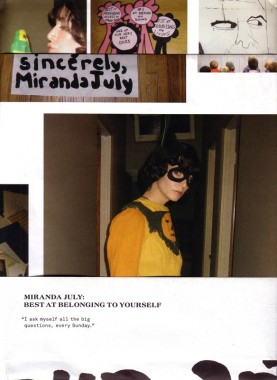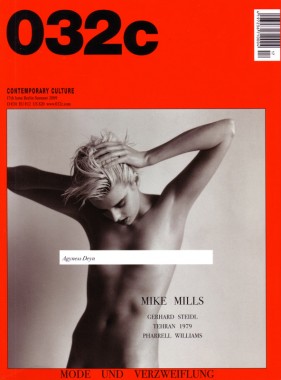Mono.Kultur 16
Mono.Kultur 16, Miranda July
Softcover, 16 pp. + poster, offset 4/1, 140 x 200 mm
Edition of 5000
ISSN 1861-7085
Published by Mono.Kultur
out of print
During this time, she also founded Joanie 4 Jackie (formerly Big Miss Moviola). Joanie 4 Jackie was a non-commercial distribution system for women video-makers in the pre-YouTube mid-1990s. Any woman could submit a video short and July would put it onto a compilation tape with nine other videos; she then re-circulated these new ‘chain letter’ tapes so each video-maker could see what others were making. Joanie 4 Jackie was an explicitly feminist project, stemming from the anti-consumerist ethos of third wave feminism. Feminist concerns are also evident in July’s early short video works, which explored mother/daughter dynamics, voyeurism, and female spectatorship. In her videos The Amateurist and Nest of Tens, her characters hunt for or establish patterns, imposing their own personal systems of control onto the bewildering world around them. She extended these themes of unexpected longing and loss in Me and You, her short stories, and her recent performances.
032c 17
032c 17, Mike Mills
Softcover, 256 pp. + Slavs and Tatars booklet, offset 4/1, 20 x 27 cm
Edition of 2000
Published by 032c
$20.00 ·
“All we ever wanted was everything,” MIKE MILLS reveals ways of getting through the recession/depression in a 40-page cover special; Ronnie Cooke Newhouse narrates a day in the life of her best friend PHARRELL WILLIAMS; publisher GERHARD STEIDL races jet lag across the Atlantic from Karl Lagerfeld’s haute couture show in Paris to Robert Frank’s Canadian solitude; distinguished historian ERIC HOBSBAWM discusses his views on the future of globalization with Hans Ulrich Obrist; SLAVS & TATARS revisits the Islamic Revolution of 1979 in Tehran with the first installment of its project 79/89/09 for 032c; AGYNESS DEYN nude story by Alasdair McLellan; gallerist MAUREEN PALEY bares her perseverance: “It’s something where you’ve been given a path that you must follow, where you don’t know what else you would do. Once you see this, many things appear that indicate the way forward for you.”
Here and There 7
Nakako Hayashi, Here and There 7
Softcover, 64 pp., offset 1/1, 210 x 297 mm
Edition of 1000
Published by Nieves
$20.00 ·
Here and There Vol.7 is dedicated to the cities of Paris and Tokyo, looking at them through the eyes of its wide contributors’ family spread around the world. We are taken into a whirlwind of overlapping stories and emotions, through the words and images of Takashi Homma, Elein Fleiss, Susan Cianciolo, Julian Gatto, Kim Gordon, Mike Mills, Benjamin Sommerhalder and most importantly Nakako Hayashi, the mind behind it all.
Here and There 1
Nakako Hayashi, Here and There 1
Softcover, 48 pp., offset 4/1, 210 x 297 mm
Edition of 1000
Published by Nieves
out of print
Here and There is the magazine of one person. The fact that Nakako’s name is credited as the author on the cover is not an egocentric statement but reveals the spirit in which she makes it. Some people make films, others write books or make artworks, and Nakako makes a magazine. It is her personal work and in that sense she makes it in her own way, unlike most magazines on the planet. It also means she is free from capitalistic rules, from imposed trends, from the industry of fashion. Instead, she is free to follow her desire and to link the magazine with her personal life.
Fireworks
Softcover, 32 pp., offset 4/4, 19.5 x 25.5 cm
Edition of 500
ISBN 978-3-905714-34-0
Published by Nieves
out of print
—Mike Mills
Humans
Mike Mills, Humans
Softcover, 32 pp., offset 4/1, 16 x 22.5 cm
Edition of 1000
Published by Nieves
out of print
Humans Manifesto.
No plan survives first contact with the enemy.
Sometimes being dumb is the only smart alternative.
Shy people are secretly egoists. Nothing is real.
Everything you see is a dream you project onto the
world. Children live out their parents unconscious.
The only animals that suffer from anxiety are the
ones that associate with humans. I don’t trust
people who are very articulate. The only way to be
sane is to embrace your insanity. When you feel
guilty about being sad, remember Walt Disney
was a manic depressive. Everything I said
could be totally wrong.

